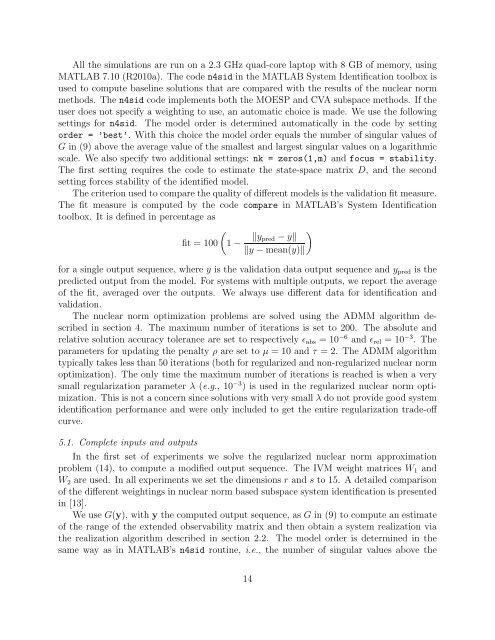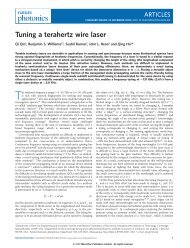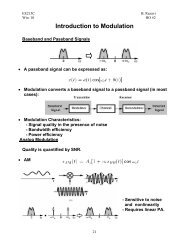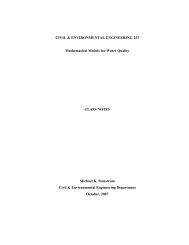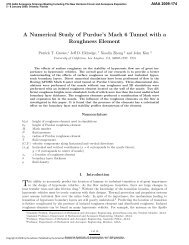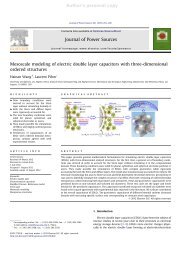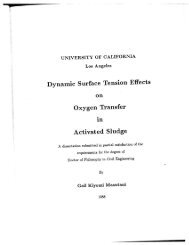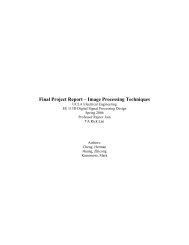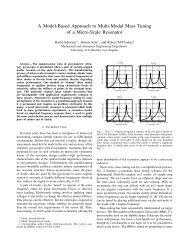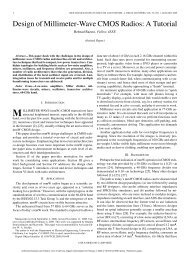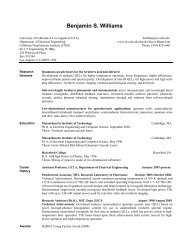Nuclear norm system identification with missing inputs and outputs
Nuclear norm system identification with missing inputs and outputs
Nuclear norm system identification with missing inputs and outputs
You also want an ePaper? Increase the reach of your titles
YUMPU automatically turns print PDFs into web optimized ePapers that Google loves.
All the simulations are run on a 2.3 GHz quad-core laptop <strong>with</strong> 8 GB of memory, usingMATLAB 7.10 (R2010a). The code n4sid in the MATLAB System Identification toolbox isused to compute baseline solutions that are compared <strong>with</strong> the results of the nuclear <strong>norm</strong>methods. The n4sid code implements both the MOESP <strong>and</strong> CVA subspace methods. If theuser does not specify a weighting to use, an automatic choice is made. We use the followingsettings for n4sid. The model order is determined automatically in the code by settingorder = ’best’. With this choice the model order equals the number of singular values ofG in (9) above the average value of the smallest <strong>and</strong> largest singular values on a logarithmicscale. We also specify two additional settings: nk = zeros(1,m) <strong>and</strong> focus = stability.The first setting requires the code to estimate the state-space matrix D, <strong>and</strong> the secondsetting forces stability of the identified model.The criterion used to comparethequality ofdifferent modelsis thevalidation fit measure.The fit measure is computed by the code compare in MATLAB’s System Identificationtoolbox. It is defined in percentage as(fit = 100 1− ‖y )pred −y‖‖y −mean(y)‖for a single output sequence, where y is the validation data output sequence <strong>and</strong> y pred is thepredicted output from the model. For <strong>system</strong>s <strong>with</strong> multiple <strong>outputs</strong>, we report the averageof the fit, averaged over the <strong>outputs</strong>. We always use different data for <strong>identification</strong> <strong>and</strong>validation.The nuclear <strong>norm</strong> optimization problems are solved using the ADMM algorithm describedin section 4. The maximum number of iterations is set to 200. The absolute <strong>and</strong>relative solution accuracy tolerance are set to respectively ǫ abs = 10 −6 <strong>and</strong> ǫ rel = 10 −3 . Theparameters for updating the penalty ρ are set to µ = 10 <strong>and</strong> τ = 2. The ADMM algorithmtypically takes less than 50 iterations (both for regularized <strong>and</strong> non-regularized nuclear <strong>norm</strong>optimization). The only time the maximum number of iterations is reached is when a verysmall regularization parameter λ (e.g., 10 −3 ) is used in the regularized nuclear <strong>norm</strong> optimization.This is not a concern since solutions <strong>with</strong> very small λ do not provide good <strong>system</strong><strong>identification</strong> performance <strong>and</strong> were only included to get the entire regularization trade-offcurve.5.1. Complete <strong>inputs</strong> <strong>and</strong> <strong>outputs</strong>In the first set of experiments we solve the regularized nuclear <strong>norm</strong> approximationproblem (14), to compute a modified output sequence. The IVM weight matrices W 1 <strong>and</strong>W 2 are used. In all experiments we set the dimensions r <strong>and</strong> s to 15. A detailed comparisonof the different weightings in nuclear <strong>norm</strong> based subspace <strong>system</strong> <strong>identification</strong> is presentedin [13].We use G(y), <strong>with</strong> y the computed output sequence, as G in (9) to compute an estimateof the range of the extended observability matrix <strong>and</strong> then obtain a <strong>system</strong> realization viathe realization algorithm described in section 2.2. The model order is determined in thesame way as in MATLAB’s n4sid routine, i.e., the number of singular values above the14


